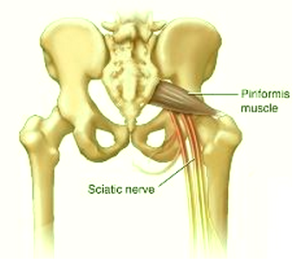Piriformis syndrome refers to the form of neuromuscular disorder which occurs as a result of the compression of the sciatic nerve. Affected individuals feel pain on their buttocks that sometimes goes down to the knees. They usually feel the symptoms after sitting for long periods of time, an injurious fall, a car accident or other activities that strain the sciatic nerve.
The diagnosis and treatment for piriformis syndrome aims to improve the symptoms that the condition brings. It should be designed individually because the severity of the symptoms differs with every person. The syndrome is often managed by specially tailored stretching exercises and therapy.

Causes of Piriformis Syndrome
The syndrome occurs when the long and thick nerves running along the flat and band-like muscles in the buttocks are compressed. The compression can be due to the spasm of the piriformis muscle. This muscle plays a very important role in the proper movement of the lower extremities by stabilizing the hip joints and rotation and lifting of the thighs. The piriformis muscles facilitate functional walking and balance.
The possible causes of nerve compression are:
- Imbalanced muscles
Imbalanced muscles place the hip joints and pelvic bones out of place, causing spasms of the piriformis muscle. This often arises due to repetitive forward movements.
- Overused hip muscles and glutes
Worn-out glutes and hip muscles also give rise to piriformis muscle spasms.
- Overpronation of foot
This is a result of the excessive inward rolling of the feet as a result of dropped arches. With overpronation, the knee turns inward causing the piriformis muscle to get overused.
- Stiffness
Stiffness of the sacroiliac joints is another possible cause of the syndrome. The sacroiliac joints pertain to the region where the spine and pelvis meet, and stiffness in this area can lead to tears in the piriformis muscle.
There are also other factors that are believed to cause the syndrome, and these are bad posture, poor body structure, falling injury and gait problems.
How common is Piriformis Syndrome?
It is difficult to determine how common the syndrome is because the symptoms mimic those of other health conditions. Studies found that those who are in their 40s and 50s are often affected by the syndrome, notwithstanding their occupations and level of physical activities. It has been found that more women suffer from the condition as well because females have broad quadriceps femoris muscle angle in the pelvis area. Around 6% of people suffering from sciatica endure the syndrome too.
Something can be done to prevent the syndrome from happening. Movements or sports that put too much strain on the piriformis muscle should be avoided. Examples of these activities are lunging and running. Proper warm up before exercising as well as gradually increasing the intensity of certain exercises are also imperative. It also helps to observe proper posture while exercising, walking or running as well as avoiding exercising or running on uneven surfaces. Taking short breaks is recommended when the person starts to feel some pain.
Symptoms of Piriformis Syndrome
People affected by the syndrome experience sciatica-like pain that radiates down to the leg. The syndrome is also manifested by painful hips and lower back. Radiating pain is also felt on the calf, while a deep dull pain is experienced on the buttocks. General pain on one side of the buttock and reduced hip mobility are also common. People affected by the syndrome find that the affected side of the buttocks has become sensitive after applying direct pressure. Pain is also felt after sitting for extended periods of time.
What does Piriformis Syndrome diagnosis involve?
Specific tests for diagnosing the syndrome are not yet available, so diagnosis is done based on the reported symptoms. This may involve the following:
- Physical exam
The doctor will use various movements to bring out pain to the piriformis muscle. Part of the physical examination is checking the patient’s medical history, lifestyle and habits.
- Imaging tests
Imaging tests like MRI might be requested to discount other possible causes of nerve compression like herniated disc. Magnetic Resonance Neurography may also be done to uncover problems linked to the sciatic nerve.
- Other diagnostic tests
Several tests are also done to achieve proper diagnosis such as Freiberg Test, Pace Test and Beatty Method.
Piriformis Syndrome treatment
The first line of treatment for Piriformis syndrome is a week or two of rest from any form of activity or sports. This may also involve reducing the intensity of certain activities like running or exercising. Other treatment options for the syndrome are:
- Physical therapy
Physical therapy is often directed towards strengthening and stretching the hip rotator muscles. This is to alleviate the compression to the sciatic nerve. Iontophoresis therapy might also be used in managing the syndrome, using either botulinum toxin injection or mild electric current.
- Medications
Doctors may prescribe anti-inflammatory medications to reduce inflammation surrounding the tendon. Corticosteroid injections or muscle relaxants may also be used.
- Deep massage
Deep massage also helps alleviate the symptoms.
- Surgery
This is only considered after all the other treatment options have failed.